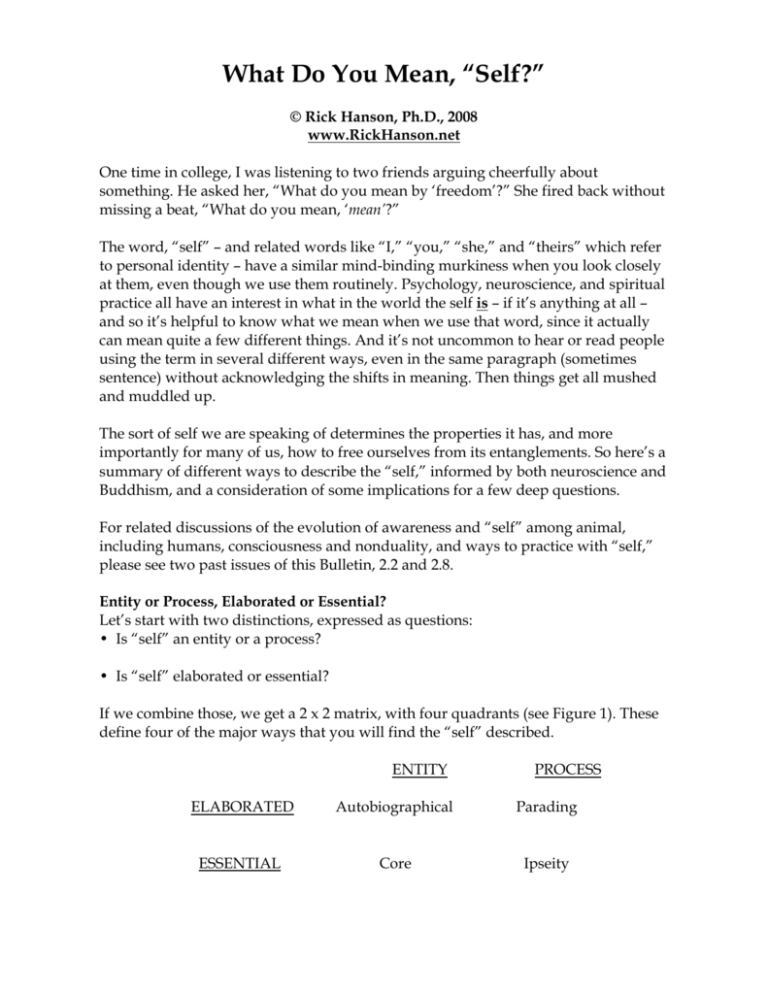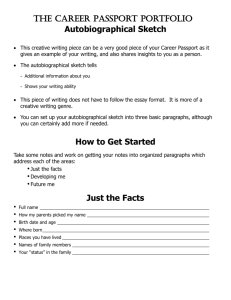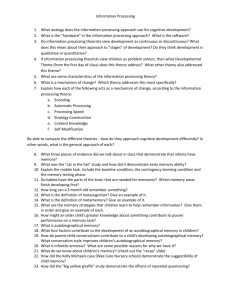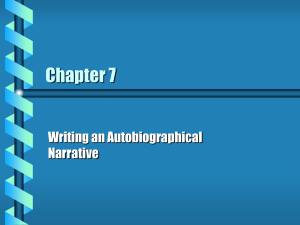What Do You Mean, “Self?”
advertisement

What Do You Mean, “Self?” © Rick Hanson, Ph.D., 2008 www.RickHanson.net One time in college, I was listening to two friends arguing cheerfully about something. He asked her, “What do you mean by ‘freedom’?” She fired back without missing a beat, “What do you mean, ‘mean’?” The word, “self” – and related words like “I,” “you,” “she,” and “theirs” which refer to personal identity – have a similar mind-binding murkiness when you look closely at them, even though we use them routinely. Psychology, neuroscience, and spiritual practice all have an interest in what in the world the self is – if it’s anything at all – and so it’s helpful to know what we mean when we use that word, since it actually can mean quite a few different things. And it’s not uncommon to hear or read people using the term in several different ways, even in the same paragraph (sometimes sentence) without acknowledging the shifts in meaning. Then things get all mushed and muddled up. The sort of self we are speaking of determines the properties it has, and more importantly for many of us, how to free ourselves from its entanglements. So here’s a summary of different ways to describe the “self,” informed by both neuroscience and Buddhism, and a consideration of some implications for a few deep questions. For related discussions of the evolution of awareness and “self” among animal, including humans, consciousness and nonduality, and ways to practice with “self,” please see two past issues of this Bulletin, 2.2 and 2.8. Entity or Process, Elaborated or Essential? Let’s start with two distinctions, expressed as questions: • Is “self” an entity or a process? • Is “self” elaborated or essential? If we combine those, we get a 2 x 2 matrix, with four quadrants (see Figure 1). These define four of the major ways that you will find the “self” described. ENTITY PROCESS ELABORATED Autobiographical Parading ESSENTIAL Core Ipseity 2 Figure 1. Four sorts of “self” 1. Let’s start with the upper left quadrant, with what people commonly regard as the self, an entity, a being, with elaborated qualities. For example, let’s take my friend and teaching/writing partner: “Rick Mendius.” He is recently married, has three children, works as a neurologist, grew up in New Mexico, has such-and-such SSN, likes good coffee, works incredible hours, and so on. The term commonly used in neuropsychology for this sort of self is the narrative or autobiographical self. It’s narrative in the sense that it is woven somewhat out of the stories we tell ourselves about our life: the ongoing commentary, evaluation, meaning-making. And it is autobiographical in two ways. First, it is a collection of descriptions that define a unique individual, such as gender, occupation, race, religion, dwelling place, parental status, son/daughter, brother/sister, social class, political views, etc. Second, it integrates perspectives about the personal past, present, and future. For example, during the day, it’s natural to think about what you will do at home that evening, and that bit of rumination is probably informed by a mini-movie – which is a narrative, by the way – of what you have done at home in the past. This complex weaving together of self-referencing memoir and planning for the future is uniquely human – and many scientists suspect that the evolution of the capacities for it in the nervous system were driven more by the social milieu of our ancestors, in small and intensely social hunter-gatherer bands, than by the physical milieu of their African savannah habitat. Other, less social animals, including nonhuman primates, are very successful at survival within that habitat without our narrative and autobiographical capacities. Nor does it look like the development of the brain was driven primarily by the need to master new tools; around Lake Victoria in Africa, methods used for making stone tools remained static for around a million years. The first stone tools appeared about 2.7 million years ago, and as our brains tripled in size over that time, there was an arms race, alright, but it wasn’t primarily about improving adaptation to habitat or about increasing capacities to manipulate technologies. The arms race was for improving social abilities, in order to thrive within the band – managing the alliances and dominance hierarchies (who grooms who?) – while working together to compete, often violently, with other bands for scarce resources. We are the most sociable species on the planet, and much of “I” is embedded in “we.” For example, observing your own stream of consciousness, isn’t most of it selfreferential ruminating about your interpersonal world? And that includes when 3 others are tacit, such as when there are references to whether an action of yours would be approved of or rewarded by others. 2. Next, moving down in the first column, we have the core self. This equates to that sense of being the same fundamental “I” across all our autobiographical situations. It’s the primary sense of “I” that comes on-line a few seconds after you first wake up in the morning. There is often little if any sense of gender or other descriptors with this self. And if you are threatened, it often comes to the forefront: “I will survive!” If the frontal lobes of the brain – the apparent neural substrate of the autobiographical self – are damaged, there can still be some functioning personal identity in the individual. It is just not based on much complexity of continuity with the past or consideration of the future. That core self relies on subcortical and brain stem structures, and when those are damaged both core and autobiographical selves disappear, indicating that the core self is foundational to the autobiographical self, at least in neurological terms. In evolution, the neural structures that are the basis of the core self in humans (or their early analogues) appeared at least a couple hundred million years ago, and perhaps earlier. Therefore, it’s a reasonable conjecture that the core self in humans is similar to the self of a higher animal, such as a lizard, squirrel, or dog. When your mind is very quiet, it feels like the autiobiographical self is minimally present at most, which presumably corresponds to a relative deactivation of its neural substrate. At those times, what seems primarily active are the foundational circuits of the core self. Certain aspects of contemplative practice – particularly the concentration meditations that focus on stilling the mind – could thus be regarded neurologically as training the brain to inhibit the neural circuitry of the autobiographical self (particularly its verbal components, centered in Broca’s and Wernicke’s Areas in the left frontal and temporal lobes) and stabilize steady activation of the core self substrate. 3. Now let’s move to the right hand column on the slide, where we regard self as process, as a verb and not a noun. In this light, whatever may be enduring across moments of time about a self is seen as a kind of standing wave, like where a stream flows over a half-submerged boulder. Notice how language carries embedded assumptions. For example, in English, is the word “I” a noun or a verb? It’s a noun, a “person, place, or thing,” isn’t it? That linguistic framing can lead us unconsciously to regard processes as reified entities. 4 It’s interesting that in Pali – the language of the earliest surviving written record of the Buddha’s teachings and the language spoken by many ordinary people of his time – there are basically no nouns: relatively persistent patterns in space-tme, whatever they are, are described as gerunds: suffer-ing, cling-ing, dog-ing, cup-ing . . . self-ing. In the upper right quadrant, let’s call the elaborated process of selfing parading. I couldn’t come up with a better term! And invite nominations. But the image of a cavalcade of characters, bustling and complicated, full of life, streaming down a passage-way of some sort, with a certain messy unstably stable coherence, endearing and perhaps a little overwhelming . . . well that kind of conveys a sense of personness proceeding through time. 4. Finally, in the bottom right quadrant, there is the word ipseity, a technical term in consciousness studies for a certain, seemingly minimal sense of an experiencing subjectivity in the stream of consciousness, life given into a first-person perspective. For example, when the mind is very quiet in meditation, and you seem to be getting pretty close to bare, rock-bottom awareness, you may still sense a subtle “beingness” that has a persistently individual quality to it. When people equate the self with awareness, that view is usually grounded in this bottom right quadrant. But as appealing as that can be – “I’m open space awareness, unbounded and free!” – there are several issues with that view. First, it can lead to a reification of awareness as a thing (one of those pesky nouns) rather than as an activity, which is the teaching of both neuroscience and Buddhism. Second, it’s a short hop from equating self to awareness . . . to identifying with awareness, which is a kind of clinging that, like other forms of clinging, leads to suffering. Third, is awareness actually personal? Neurologically, awareness is founded on the representing capacity of the brain, and that capacity is as generic and impersonal as the capacity for taste or fear. Phenomenologically, in terms of personal experience, aspects of self – including a minimal ipseity, the barest possible sense of “I” as an experiencing subject – arise within awareness but they are not awareness itself. Awareness as the open field of presence, of knowing, in which mind-objects appear and then disperse, is regarded in Buddhism (particularly Tibetan) to have two qualities: emptiness (the capacity to represent) and luminosity (a self-sustaining kind of radiance); additionally, some schools ascribe a quality of universal compassion to awareness. But that’s it: no “I” or “mine.” 5 Last, conceptually, why use two words when one will do? If “self” and “awareness” mean the same thing, shouldn’t we junk the word, “self?” But there are plenty of aspects of “self” – in each of the four quadrants – that have nothing to do with awareness, so we still need to come to terms with those aspects even if, in some ways, “self” and “awareness” overlap in their nature. True – or Useful? OK – Now having laid out this structure, let’s take it a step further and make another distinction, this time between whether something is true or whether it is useful. For example, we could regard this 4-quadrant model in terms of whether it is true: Is there really an autobiographical self? Is there ipseity? Alternately, we could ask, is it useful: Is it beneficial in some way, such as for how you treat yourself and others, or how you progress in your spiritual practice? The Buddha’s general approach was to focus on whether something was useful, in terms of reducing suffering and increasing benefits to oneself and others. So even when he was asking people whether something was true, his larger frame was usually pragmatic, utilitarian – and often he was really asking whether it was useful to regard something as true. The Buddha is not a bad person to take one’s cues from – so here is the central question of this little essay: How is it useful for you to regard self . . . or selfing? So, in light of the points made so far about “self” and ways to regard it, here is a consideration of four distinctions that naturally come to mind. I pose them as questions, and then offer brief comments – and really invite you to investigate these questions for yourself. Existent or Nonexistent? Does self/selfing exist, or is it a kind of illusion? By ”exist,” the question asks whether self/selfing has a reality distinct from the observation of it. Personally, I think that the granite deep inside Mt. Everest exists whether anyone is aware of it or not, that the planets circling faraway stars existed long before astronomers discovered them, and that neurons fire inside your brain whether you know it or not. This is the materialist presumption. No one can prove it. But most people, and just about all scientists, consider the alternative – that matter/energy depends for its existence on the awareness of conscious beings – to be highly implausible. So for our purposes here, let’s assume that existence . . . exists. 6 By the way: In terms of quantum physics and the Heisenberg uncertainty principle, just because uncertainty about a particle’s position decreases as certainty about its momentum increases does not mean that the existence of the particle depends on observation. Think of all the particles in the universe that no scientist is observing in a cloud chamber: do they not exist? Further, even though it is possible to do increasingly clever manipulations of “entangled” quantum particles to create cool stuff like “spooky action at a distance” in which the observation of one particle determines the nature of the other particle faster than light can travel . . . in the ordinary world of atoms and molecules all around us, including the ones functioning just fine in your brain right now to enable you to read these words, all these quantum entanglements “collapse” just fine without observation to form the material world. The jury is out on whether quantum phenomena require some mysterious underlying Transcendental Consciousness to operate – since the issue is currently unanswerable – but there is no question that quantum particles exist and dance together without any human awareness involved. The implications of quantum mechanics for human consciousness and the nature of everyday material reality can too easily be romanticized and overstated. Within the framework of material reality, patterns exist, like the lace of foam on a wave, or the modulation of the frequency of a radio wave that carries the Hallelujah chorus, or the momentary neuroelectrical assembly that (in ways that are still far from clear) is the material substrate of your immaterial perception of, let’s say, a carrot. So too, in even more complex ways, the pattern that is self/selfing – in each of the four quadrants above – does indeed exist. Self/selfing consists of patterns in the mind – in standing waves of information flows – that correspond to patterns in the brain. In short, self/selfing exists. It is questions about the nature of that existence that have bedeviled philosophers, psychologists, mystics, neuroscientists, and people in general throughout history, and as long as any human being or our ancestors has looked up at the stars and wondered, even wordlessly, “Who am I?” Compounded or Irreducible? Is self/selfing compounded, or is it in some way comprised of an essence that cannot be reduced to any further parts? In terms of the quadrant above, neuroscience would regard all four forms or definitions of self/selfing as certainly compounded – which is to say, based on 7 underlying neural networks, such as the “default network” or the “dorsal medial prefrontal cortex” or a “thalamo-cortical complex” that can be decomposed further into circuitry that in turn can be divided into neurons . . . made of parts . . . made of molecules . . . made of . . . and so on. This would apply even to the most elemental subjectivity present in ipseity: if it depends on underlying neural structures and activities – the central operating thesis of neuropsychology – then it is compounded of parts since that is the nature of its neural substrate. I believe that Buddhist teachings would clearly regard the “elaborated” row – the autobiographical and the parading self – as also compounded: made up of memories, personal attributes (as in the Abhidhamma), mental formations, etc. Regarding the “essential” row, the original teachings of the Buddha (the core of the Theravadan wing of Buddhism) described a process in which the enactment of a presumed self gradually declines, disappearing entirely at the stage of the Arahant, the fully enlightened being. This progressive process implies that even the most elemental self/selfing must be made of parts since it diminishes its scope and influence bit by bit. Dependent or Unconditioned? Does self/selfing arise dependently upon preceeding causes, or does it in some sense exist independently, unconditionally? Pretty much the same answer as above. Within brain science, each of the four modes of self/selfing has causes, and when those causes change – such as waking/sleeping, strokes, injuries, dementia, psychedelics, object of attention, task at hand, etc. – so does the self/selfing. And in Buddhism, both the Theravadan and the Mahayana (Zen, Tibetan, Pure Land) wings reject the notion of a personal self that persists independently of causes. But here’s where it gets tricky, particularly within “nondual” perspectives: If the ground of self/selfing is ultimately consciousness, and if the nature of that consciousness is ultimately unconditioned, then does it not follow that . . . self is unconditioned? In other words, not dependent on preceding causes for its existence. In the frame of “Thou art That” – a core view of the nondual, Advaita schools in Hinduism – the Thou is the self and That is God/The Ultimate Ground/The Unconditioned. So Thou is ultimately unconditioned in that perspective. I’m not going to attempt a resolution of this: that’s high above my pay grade! But one thing at least is clear: the Buddha for one relentlessly critiqued the identification of anything as “I, myself, or mine.” And he drove a similar critique of the prevalent belief of his time in an “atman,” a soul-essence that exists independent of causes. The 8 term, anatta, means “not-atman,” and anatta is one of the three characteristics of existence in Buddhism; the other two are anicca (impermanence) and dukkha (suffering). Not-soul-essence is thus a fundamental Buddhist teaching. Of course, you need to see for yourself if you consider that viewpoint to be true . . . and perhaps more importantly, if you consider that viewpoint to be useful. Mortal or Immortal? Does self/selfing end when the body ends (dies), or does it persist in some way? This the question most people really want answered. Faced with inevitable death and usually wanting to keep living, it’s natural to hope for some sort of personal continuity. As the saying goes: “Who in the world would want to live to a hundred?! Well, someone who’s ninety-nine.” From a strictly Western science perspective, when the body dies, so do you. Period. Of course, the “you” here is a mental pattern of self/selfing. The physical body persists for a while as a coherent pattern, and many if not most of its constituent atoms will last as long as the universe does. In short, self/selfing emerges as an impermanent pattern of mind, which emerges as an impermanent pattern of the nervous system, which emerges as an impermanent pattern of the body, which emerges as an impermanent pattern of atoms and molecules, which disperses and re-form as rain, as dirt, as carrots, and as the bodies of other people. From the perspective of the Buddha, he undeniably taught that there is reincarnation, which means that some patterning that is unique to a particular individual, and shaped karmically by the intentional actions (of thought, word, and deed) of that individual, must persist after the body dies. Whether that is actually true or not, I am not sure. But even within the framework of reincarnation, the Buddha made it clear that there is no atman, no soul, that persists eternally from life to life, but rather a collection of qualities – what Chogyam Trungpa called our bad habits – that change over time, that should change if one is serious about practice. And at the end of the journey, those qualities change so thoroughly that there are no longer any causes or conditions that would give rise to another life in any realm. In the Buddhist view, in the most complete sense, anything that we might consider to be self ultimately does – and ultimately should – come to a mortal end. Here’s the Buddha’s description of his own enlightenment (from Bhikkhu Bodhi’s wonderful anthology, In the Buddha’s Words, p. 67): “I directly knew: ‘Birth is 9 destroyed, the spiritual life has been lived, what had to be done has been done, there is no more coming back to any state of being.’” * * * To conclude, here is a final question: How could it be useful to you to regard your self – the “I, me, or mine” – as fluid, compounded, conditioned, and impermanent?








